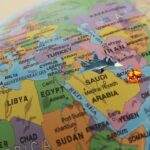
Israel vs Iran Conflict
1. What’s happening in Israel & Iran Conflict?
As of June 18, 2025, Israel and Iran are locked in an intensifying air war that has now reached its sixth consecutive day. Both countries are exchanging missile strikes: Iran has launched multiple ballistic missile barrages targeting Israeli cities like Tel Aviv, while Israel has responded with sustained airstrikes against Iranian military infrastructure — including sites in Tehran and its outskirts .
According to Reuters, Israel has warned civilians in parts of Tehran to evacuate ahead of further strikes targeting Revolutionary Guard-linked facilities and missile sites such as the Khojir complex . Tehran and neighboring cities like Karaj have also experienced explosions .
2. Trump’s Intervention in the conflict : “Unconditional Surrender”
Former U.S. President Donald Trump has reentered the fray with provocative rhetoric. On Truth Social, he demanded Iran’s “UNCONDITIONAL SURRENDER,” asserting that the U.S. knows where Ayatollah Khamenei is hiding — though he claimed there are no current plans to target him .
Meanwhile, Trump appears to be weighing deeper U.S. involvement. He’s spoken to Prime Minister Netanyahu, convened a 90-minute meeting with the National Security Council, and instructed the deployment of additional fighter jets — even organizing a new “Middle East task force” within the State Department . He’s considering support for Israeli strikes on Iranian nuclear sites, though no direct U.S. participation has been confirmed .
3. Human Cost & Collateral Damage
Casualty figures from varying sources highlight the conflict’s brutality:
Iranian side: Official Tehran reports at least 224 dead, mostly civilians. However, other groups, including a U.S.-based human rights organization, put the toll as high as 585 deaths .
Israeli side: The IDF acknowledges 24 civilian fatalities .
Mass evacuations are underway, particularly in Tehran. The city’s Grand Bazaar has closed, and civilian fears continue to grow .
4. Strategic Battleground: Nuclear Sites & Cyberwar
Israel’s strikes aren’t random — they are explicitly targeting Iran’s nuclear and missile infrastructure:
Sites hit include uranium enrichment plants (Natanz), Revolutionary Guard-linked university facilities in Tehran, and missile production complexes (Khojir) .
The IAEA confirmed that an Israeli strike hit Natanz’s underground enrichment halls . Other deeply buried sites like Fordow remain resistant to conventional strikes .
Complementing the kinetic assault is a cyber war, with Israel reportedly launching major digital offensives against Iran’s systems .
5. Geo-Political Ripple Effects
A. Global Energy Markets
Oil prices have spiked amid fears of supply disruptions, particularly through the Strait of Hormuz. Brent crude rose to $76.64/bbl and U.S. WTI to $75.07/bbl . Any escalation or interference with tankers could exacerbate inflation and severely impact global economies.
B. Diplomatic Fallout
UAE has warned the situation could spiral into a broader regional war if not managed carefully .
G7 leaders, including the UK’s Keir Starmer, are urging caution as the crisis unfolds alongside their summit .
IAEA concerns are mounting over potential “radiological and chemical contamination” from attacks on Iran’s nuclear facilities .
C. U.S.–Iran Negotiations in Limbo
Efforts to revive nuclear diplomacy hit a wall. A meeting planned for June 15 in Oman was suspended following the Israeli strikes and subsequent escalation .
6. Leadership & Command Disruption
Israel claims it has eliminated several senior Iranian military figures — including Gen. Ali Shadmani — and other top advisers in Khamenei’s inner circle . The loss of these command voices, coupled with communications blackouts (e.g., mobile phone bans), is viewed as a blow to Iran’s strategic decision-making .
7. What Comes Next?
Both nations appear intent on intensifying the confrontation:
Israel claims air supremacy and is preparing to escalate further — with eyes now on tough-to-reach nuclear facilities .
Iran has fired approximately 400 missiles and drones in retaliation . They’ve also reportedly deployed advanced hypersonic Fattah‑1 missiles .
The U.S. is sending more fighter jets and refueling support, while shuttling military assets into position .
8. The Dangerous Rationale
Israel justifies its campaign as a preemptive, sustained effort to quash Iran’s nuclear ambitions, a concern heightened since the Oct 7 Gaza War . Iran maintains its right to peaceful nuclear enrichment and claims its missile launches are defensive counterstrikes .
9. Regional and International Stakes
This confrontation risks deeper destabilization across the Middle East:
Attacks on energy infrastructure and shipping lanes could divert trade and escalate beyond local borders .
Gulf states like the UAE are watching warily, urging restraint and multilateral engagement .
International bodies — the UN, NATO, IAEA — are on alert, warning of global security and environmental fallout .
10. Final Word: The Tenuous Balance
The air war stands at a precarious point. With Israel’s sustained strikes and Iran’s retaliatory strikes — bolstered by Trump’s aggressive rhetoric and possible U.S. engagement — the conflict could spiral. Outcomes to monitor include:
1. Nuclear Infrastructure: Israel may press harder on Fordow and similar hardened sites — possibly drawing U.S. into direct military support or involvement.
2. Oil Market Volatility: Price spikes at $80+ could impact global inflation and pressures on central banks like the Fed .
3. Diplomatic Shenanigans: Any resumption of U.S.–Iran negotiations in Oman could overshadow the conflict – yet the window is narrowing.
4. Broader War Risk: Spillover into Lebanon, Syria, Gulf waterways — intentional or accidental — could ignite regional war.
Conclusion
The Israel‑Iran air war’s sixth day has thrust the region into renewed crisis. With mounting civilian casualties, strategic cyber warfare, nuclear risk, and the U.S. now potentially drawn in, the stakes have never been higher. Oil markets, global diplomacy, and regional stability all hinge on whether cooler heads can prevail — or if the fire spreads.
Stay tuned as global attention focuses on whether the conflict de-escalates or broadens dangerously.
Links related to article – Israel & Iran Conflict






Leave a Reply